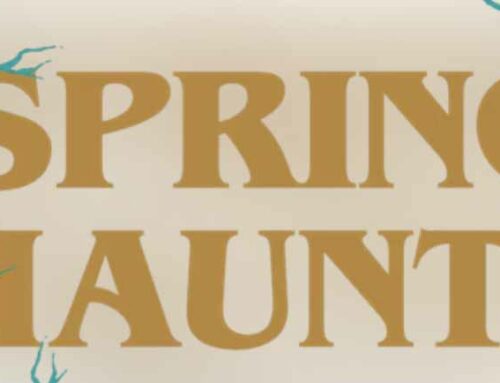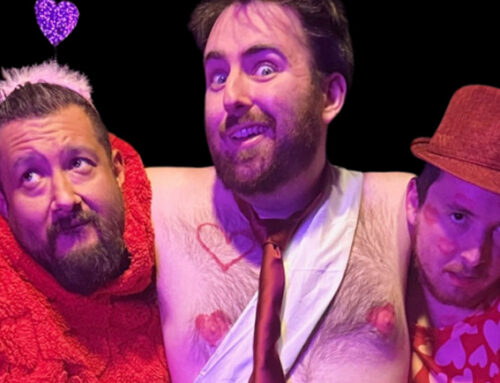Do you like blood, horror, and vampires? How about sexy succubi dancing around in black nightgowns? Maybe intimate horror theater that brings you to the edge of your seat? Well if any of these excite you, then I implore you to check out Theatre 68’s Dracula at the NoHo Arts Center.
As I stepped through the doors of the theater, the women danced all around, spider-like and sexual. One hugs the door frame as I enter and moans softly. She wears a loose black nightgown. Another crawls demonically across the floor, and a third sits on chaise lounge laughing manically. Then I notice a woman in white, wrapped across her chest, arms, and face in bandages. She stands statically, strong, unwavering. I move to find my seat, and it’s easy to do so because the theater is small and intimate. Three rows total and 48 seats in all. No matter where you sit, you are in the action. As we wait for everyone to find their seats, the women in black dance around, tormenting the others in white, laughing, and bearing their fangs for all to see. As the final few patrons find their seats, the succubi move forward to unwrap their maiden in white. As they release her from her bindings, they literally open her eyes to the world. They dance around her with her bandages and then she screams–blood curdling–and the lights go out.
The story is adapted from Bram Stoker’s classic vampire novel by Jayce Johnson and comes to us after a highly successful 2014 run in New York City. The story line follows that of the original quite well, with a few liberties taken. The main different is a great one: the story is tweaked slightly to bring the women to the forefront. The play now focuses on the empowerment, freedom, and sexuality of the women: Renfield (now a woman) fights against her madness and for her sexual freedom, Lucy struggles against her mother and her growing sexual feelings, and Mina glues the show together in her love for Lucy, her husband, Jonathan, and the mysterious Dracula. Furthermore, the dancing succubi from the beginning serve as all of the background characters: Lucy’s mother’s maids, Dracula’s vampire brides, and even coat-hangers and candle-holders. The second change to the story transforms Dracula into a sympathetic character who Mina argues may not be evil, but may simply be trying to release the women from the doldrum lives. This may neuter Dracula from his original incarnation, but it doesn’t change the ferocity that Robert Homer Mollohan brings to the character when his life is threatened. Considering the tone of this work, Dracula appears sympathetic, as a liberator of oppressed women, and the men fight against him to bring their women back to their safe, docile homes.
Renfield (Kristin Lerner), who plays the insane inmate awaiting her master’s return, is the first standout character. She transforms from a calm and collected patient to a brutally insane inmate, repeatedly beating herself in the face–releasing blood upon the stage. She nails every scene she’s in, and made me sympathize with her consistent devotion despite being isolated. Mina Murray (Rachel Zink) is another standout. She is the glue that holds the play together–and as her character transforms, Zink easily conveys strength, tenderness, and lust in her performance. Yet another standout, a character with no lines, is a background succubus played by Kara Gibson. I found myself entranced by her acrobatic movements. She was very limber, and spider-like as she eased her way across the stage, often pausing to reveal a ferocity in her face (and likewise, her hair). She captivated the audience’s attention during multiple scenes as a background character–demonstrating the strength of her skill.
The stage is as much a character as any of the actors. While the space and set pieces are extremely limited, the audience’s imagination along with the sounds and lights of the set serve to craft the most beautiful set pieces. I could see Jonathan whisked away on a train at the start and Renfield locked back in her cell by only the fantastic lighting, a single doorway, and the sounds of the train whistle or inmates screaming, respectively. I was truly surprised at how well the lighting and sounds were used to bring the set to life. Further, the actors knew how to work the space, filling the background of important scenes with the four succubi, who take on the aqueous role of whatever they need to be. The walls were painted with chalkboard paint, which allowed scenes to be transformed by insane scribbles, truly degenerating into madness as the show climaxed. This performance could easily fill a stage two to three times the size. Finally, for those with a keen eye, there are multiple references to classic horror scattered throughout, notably Nosferatu and The Exorcist. This will make any horror fan squeal in their seat (as I did).
And the blood, who could forget the blood? Blood is as integral to the story as the vampires themselves. So needless to say, the stage was drenched in blood by the time the performance concluded. You can wear nice clothes to the performance though–as much as I wanted there to be, there was no “splash zone”.
In summary, Theatre 68’s Dracula is a new hyper-sexualized and female-empowered version of the classic. The acting is wonderful, the mood is tense and scary, and the deaths extrude blood. Even in the slow moments of the story, there is always something to look at because nightgown-clad succubi dance or pose as a backdrop. The NoHo Arts Center provides an intimate setting that puts the action right in your face. I do suggest you use the bathroom prior to the show, as it is a 90-minute performance with no intermission. Sophia Watt and Ronnie Marmo have created something beautiful, and it’s worth seeing if you are a fan of horror, vampires, or just good theater.
NOHO ARTS CENTER
11136 Magnolia Blvd.
North Hollywood, CA. 91601
GENERAL TICKETS:
$25.00 General Admission
Purchase tickets online at: http://www.plays411.com/dracula
For additional information: www.Theatre68.com 323.960.5068











